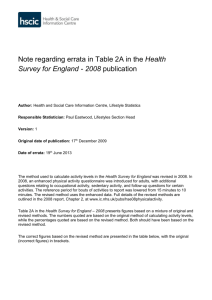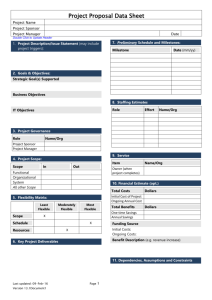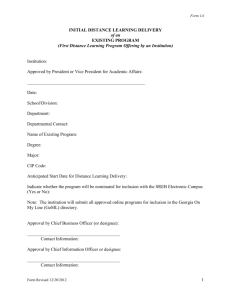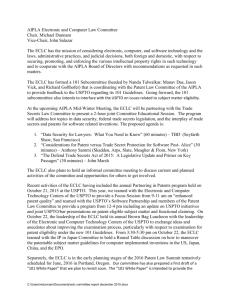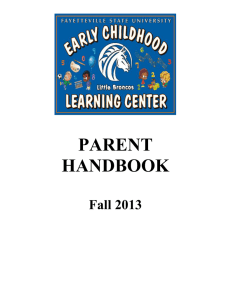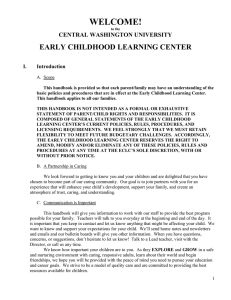ECCP Charter - The Civic Canopy
advertisement
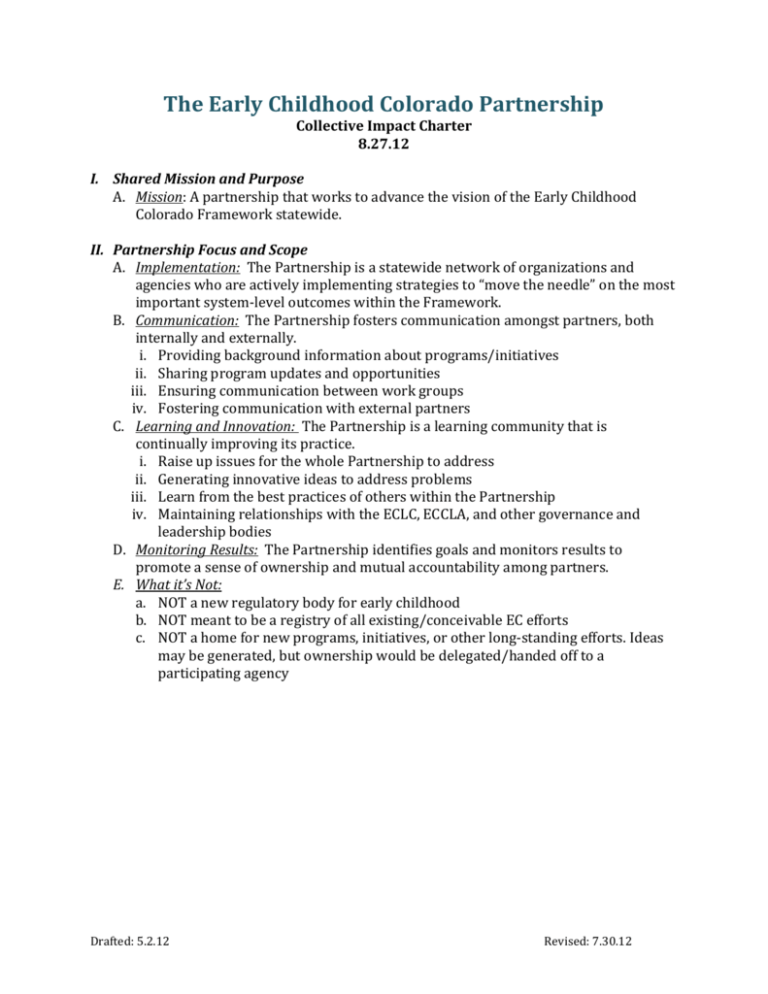
The Early Childhood Colorado Partnership Collective Impact Charter 8.27.12 I. Shared Mission and Purpose A. Mission: A partnership that works to advance the vision of the Early Childhood Colorado Framework statewide. II. Partnership Focus and Scope A. Implementation: The Partnership is a statewide network of organizations and agencies who are actively implementing strategies to “move the needle” on the most important system-level outcomes within the Framework. B. Communication: The Partnership fosters communication amongst partners, both internally and externally. i. Providing background information about programs/initiatives ii. Sharing program updates and opportunities iii. Ensuring communication between work groups iv. Fostering communication with external partners C. Learning and Innovation: The Partnership is a learning community that is continually improving its practice. i. Raise up issues for the whole Partnership to address ii. Generating innovative ideas to address problems iii. Learn from the best practices of others within the Partnership iv. Maintaining relationships with the ECLC, ECCLA, and other governance and leadership bodies D. Monitoring Results: The Partnership identifies goals and monitors results to promote a sense of ownership and mutual accountability among partners. E. What it’s Not: a. NOT a new regulatory body for early childhood b. NOT meant to be a registry of all existing/conceivable EC efforts c. NOT a home for new programs, initiatives, or other long-standing efforts. Ideas may be generated, but ownership would be delegated/handed off to a participating agency Drafted: 5.2.12 Revised: 7.30.12 Broader Partnership Work Groups Steering Committee Staffing III. Partnership Organization: The overall structure of the Partnership follows the general outline of the “Constellation Governance Model,”i a model of collaborative governance developed to allow existing networks of partners to form self-organizing work groups within a broader “ecosystem” of work within a field. It consists of the following elements, adapted from the original model: A. Broad Partnership – the full membership of individuals, organizations, and institutions dedicated to the vision of the Early Childhood Colorado Framework. B. Steering Committee – a coordinating body that has the following roles: i. Works in between meetings to help steward the Partnership and work groups ii. Provides strategic leadership and stewardship to the overall partnership 1. Catalyzes work groups around issues important to the Partnership 2. Notices duplications and seeks to reduce them 3. Links and connects existing initiatives iii. Maintains relationships with ECCLA, ECLC, EC funders, local councils etc. iv. Monitors the progress of the Framework In Action and/or the progress of the work groups v. Recommends decisions regarding staffing and secretariat functions vi. Provides outreach functions: who is missing today and how do we get them to our table? vii. Ensures communications among/between work groups and Steering Committee C. Partnership Work Groups – small teams of individuals that come together to work on a specific goal within the broader Partnership. Work Groups are guided by a common set of parameters: i. Emerge as needed to ensure goals are met—driven by real need to work together ii. Some will be long-standing, some short term. iii. Visible to all partners iv. Membership is clear, open, and structured 1. Each work group is open for anyone to join Drafted: 5.2.12 Revised: 7.30.12 2. Work groups encourage intentional relationships—including family leaders where appropriate 3. Work groups keep an official roster of who serves on that work group v. Progress is measurable vi. There is structure, but not rigidity vii. To ensure connectivity with others working on the Framework, work groups consider a range of questions as they form and as they monitor their own progress: 1. Should we be connected to other entities? Who are we missing? 2. How should we function? 3. What types of policy can we help influence/be a part of? 4. How are we in alignment with ECLC or other groups? 5. How often do we need to report/interface with other groups? D. Backbone Organization (Secretariat) – the staffing entity that provides the following functions to the Partnership: i. Oversees basic partnership function ii. Provides leadership, facilitation, staffing, administration, data management iii. Maintains technology to make visible to all what is happening in the various Work Groups Provides training for Work Groups IV. Membership: Membership in the Partnership is open to anyone interested in the vision of the Framework. To preserve the stability of the Partnership, membership entails an intentional commitment to participate, at some level, in the work of the Partnership. A. Open but Defined Open to any partner, but all members are asked to officially sign on and be listed in contact directory B. Reciprocal Expectations i. “What you get” … 1. Safe place for peer connection & collaboration 2. Communication about the issues/the work being done 3. Structures for collaboration 4. Appreciative Inquiry 5. Expertise 6. Workgroup support 7. Contact list of Partnership network ii. “What you give” 1. Sign up 2. Show up 3. Speak up 4. Follow up 5. Finish up 6. Drink up! (celebrate successes!) C. Intentionally Inclusive Recruitment i. Moving beyond a Denver-centric approach to include rural/frontier members; there ii. Identifying partners from SE/SW/NW/NE corners of Colorado Drafted: 5.2.12 Revised: 7.30.12 iii. The Partnership will continue to monitor membership for appropriate and purposeful partners, and will recognize when membership has gotten too broad iv. “On-boarding” new partners will balance the need to ensure shared understanding with the realities of busy schedules V. Results-Based Accountability and Continuous Improvement: To ensure that the positive momentum of Partnership meetings is not lost in between gatherings, Work Groups will adopt a continuous improvement model that ensures follow through, reflection, and resolution on the plans that are created. A. Focus on Outcomes at Multiple Levels i. Population-Based Results—defining what well-being will look like for children and families ii. Indicators of Success—Defining how we will measure progress toward results iii. Measures of Performance—Ways of determining effectiveness at the program, agency, or system of care level iv. Milestones of Progress—Ways of measuring the improvement of the system building efforts B. Work Plans and Follow Through i. Work groups use planning tools and frameworks to chart out their work ii. Partnership meetings include follow up reports and communication strategies to track progress iii. Impact on Results and Milestones is measurable and tracked over time C. Acknowledge Completion i. Need to celebrate/appreciate accomplishments along the way VI. Shared Measurement: At the heart of this approach lies the effective use of data. The Partnership will develop and utilize a shared measurement system to set clear goals and indicators of progress, gather data on those indicators, and review progress over time. This process will require a series of intentional steps: A. Determine Measureable Goals : Set clear goals and allow for different ways of measuring progress at different levels (Results, Indicators, Performance Measures, Milestones of Progress) i. As percentages ii. As categories of “meeting/not meeting” the goals B. Determine Types of Measures and What Data to Collect i. Child & Family measures: keeping the end goal in mind. Unified, prioritized (not necessary comprehensive) dataset determined by the Partnership. Realistic benchmarks identified. ii. Needle-moving, intermediate measures: Systems strategies take time to implement and while their impact on child/family measures may be felt, they may not be measured until several years after implementation. Needle moving measures may reflect efficiencies, cost savings etc. iii. Systems-level changes: Measurement of changes that have occurred with regard to partnerships, funding, policy, public engagement, shared accountability, and generating education and leadership opportunities. Drafted: 5.2.12 Revised: 7.30.12 iv. Qualitative measures: Anecdotal data on the work of the Partnership, stories out-in-the-field, reasons for celebration, when a particular initiative is completed and self-reflection of the process is desired v. Process measures: Measures the impact of actual Partnership activities (processes), effectiveness of meeting structure, etc. Supports ongoing quality improvement. Surman, Mark and Surman, Tonya. “Listening to the Stars: The Constellation Governance Model of Social Change.” Social Spaces, 2008. Lien Centre for Social Innovation: Singapore Management University, Singapore. i Drafted: 5.2.12 Revised: 7.30.12




